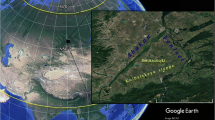Abstract
In pre-Columbian times, the Zenu Indians established drainage systems in the wetlands of the Colombian Caribbean that enabled them to exploit this rich ecosystem in a sustained manner. Modern inhabitants of the region are, however, exposed to a regimen of periodic flooding that limits their productive activities. In addition, they are surrounded by large cattle ranches that occupy almost all the land and are responsible for the disappearance of forests that sustain the wild fauna. These peasants employ a classification system for the fauna that favors the criterion of habitat over that of morphology to distinguish categories of animals. Secondary forest animals inspire carnival dances, folk tales, poetry, and songs, while insects and other invertebrates are barely represented in the oral tradition. Fishing provides the principal source of protein for many families, but there are no mechanisms to control the use of large nets that exhaust the resource. The capture of reptiles such as iguanas, turtles, and crocodilians is intensive and is not based on studies that determine the state of the populations and the impact of hunting activities. The author draws attention to the need to take into account local representations of animals in programs aimed at conserving the wetlands and their fauna. She discusses the popular nomenclature, knowledge, attitudes, and beliefs regarding the fauna of a wetland region of the Colombian Caribbean to assist in the design of programs for the sustainable exploitation of the resources of this ecosystem, vital to the survival of local fishermen and peasants.
Similar content being viewed by others
References
Álvarez, O. J. (2000). “Animales en el mundo festivo de la depresión momposina.” Boletín de Antropología 14(31): Medellín, 88103.
Árquez Van-Strahlen, O. (1993). “Vaqueros y Corraleros en la Depresión Momposina.” Boletín Historial, Órgano de la Academia de Historia de Santa Cruz de Mompox 26: 215–236.
Berlin, B. (1992). Principles of Categorization of Plants and Animals in Traditional Societies. Princeton, New Jersey: Princeton University Press.
Espinal, L. S. (1992). Apuntes ecológicos. Facultad de Ciencias. Medellín: Universidad Nacional de Colombia.
Falchetti, A. M. (1994). El oro del Gran ZenÚ. Metalurgia prehispánica en las llanuras del Caribe Colombiano. Santafé de Bogotá: Banco de la RepÚblica.
Fals Borda, O. (1979). Mompox y Loba. Historia doble de la Costa. Tomo I. Bogotá: Carlos Valencia Editores.
FUNDACÍCN NEOTROPICOS (1996). Estudio de prefactibilidad ambiental. Proyecto adecuación de tierras. Fase I. Isla de Mompox. Bolívar (mimeo).
FUNDACÍCN NEOTROPICOS (1997). Estudio de prefactibilidad ambiental. Proyecto adecuación de tierras. Fase II. Isla de Mompox. Bolívar (mimeo).
FUNDESCALA (1995). Plan de Manajo ambiental del Complejo Cenagoso de Pijiño. Municipios de San Zenón y Pijiño. Santa Marta: CORPAMAG.
García, L. C. and E. Dister (1990). “La planicie de inundación del medio-bajo Magdalena: restauración y conservación de hábitats.” Interciencia 15(6): 396–410.
Hainard, J. and R. Kaehr (de) (1987). Des animaux et des hommes. Musée d'ethnographie. Neuchatel.
Legast, A. (1980). La fauna en la orfebrería SinÚ. Bogotá: Litografía Arco.
Plazas, C., A. M. Falchetti, J. S. Samper, and S. Archila (1993). La sociedad hidráulica ZenÚ. Santafé de Bogotá: Banco de la RepÚblica.
Posada, C. and J. Echeverri (2000). “Oralidad en el bestiario momposino.” Boletín de Antropología 14(31): Medellín, 75–87.
Rivera, M. A. (1997). “Aspectos del marco político y normativo de los humedales en Colombia.” In E. Guerrero (ed.), Una aproximación a los humedales en Colombia. Fondo FEN, UICN.
Turbay, S. (1993). Croyances et pratiques religieuses des Zenus de la plaine CaraÏbe colombienne. Doctoral thesis. Paris: Escuela de Altos Estudios en Ciencias Sociales.
Turbay, S. (1995). “De la cumbia a la corraleja, el culto a los santos en el bajo SinÚ.” In Revista Colombiana de Antropología, vol. XXXII. Santafé de Bogotá.
Turbay, S., G. Gómez, A. D. Lopez, O. Alvarez, and C. Alzate (1999). Bestiario Momposino. Representaciones sobre la fauna en la isla de Mompox y en el complejo cenagoso de Pijiño. Universidad de Antioquia, Colciencias, Medellín, Informe final de investigación, sin publicar.
Turbay, S., G. Gómez, A. D. López, O. Alvarez, and C. Alzate (2000). La fauna de la Depresión Momposina. Medellín: Lealón.
Ulloa, A., H. Rubio, and C. Campos (1996). Trua wandra. Estrategias para el manejo de fauna con comunidades embera en el parque nacional Utría, Chocó, Colombia. Buena Semilla, Santafé de Bogotá.
Urán, A. (2000). “Es el modelo taxonómico una guía adecuada para la estructura y las clasificaciones populares?” Utopía Siglo XXI 1(5): Universidad de Antioquia, Medellín, 9–16.
Author information
Authors and Affiliations
Corresponding author
Rights and permissions
About this article
Cite this article
Turbay, S. Folklore and popular conceptions regarding the fauna of a wetland area on the Caribbean coast of Columbia. Agriculture and Human Values 21, 105–110 (2004). https://doi.org/10.1023/B:AHUM.0000029396.05508.93
Issue Date:
DOI: https://doi.org/10.1023/B:AHUM.0000029396.05508.93




